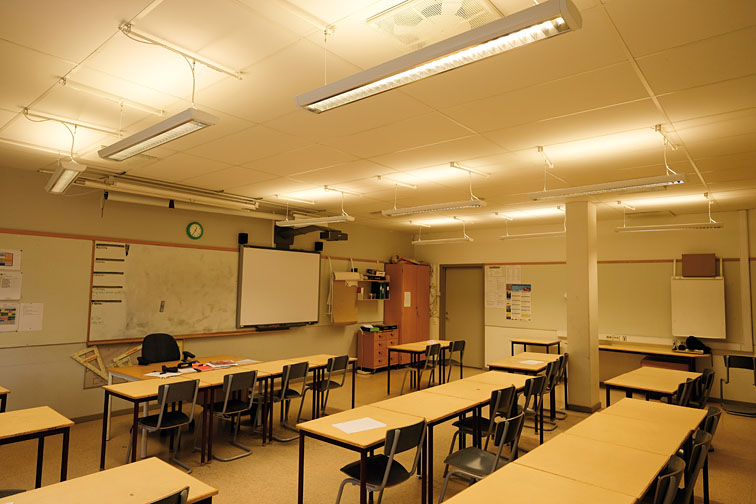Malmo is a multicultural city with a fast growing population. One effect of this is that the city has to build 35 new schools in the next few years.
The City of Malmo governors and engineers soon realised that top class education would be crucial to the success of the city.
A review of lighting in the existing schools showed it to be old and inefficient. New lighting was needed and it was decided to make a trial of human centric lighting, HCL, to make the classrooms more attractive and more conducive to learning.
The first installation was Lindeborg school in October 2015. The new lighting system changes both the illumination level and the colour temperature (Warm or Cool). The results have been very positive and the Sweden Parents Association, Riksförbundet Hem och Skola, (Home and School) is keen to promote the use of HCL in other schools.

Background
The school wrote a technical lighting brief and sent it to five companies with different areas of expertise. These were: a Research and Development company, H & V specialists, Electronics company, a traditional luminaire manufacturer and a lighting company specialising sunlight and daylight.
However, none could offer a complete solution and so the City decided to manage the complete specification and installation process themselves. The result of this work is that there are crucial questions you need to ask when embarking on a scheme such as this. Some of the most important are:
- What defines a good LED and a good luminaire?
- Where can we buy them?
- How will they communicate with control system?
- What control system is the best?
- Where can you find lighting schedules/scene settings?
- What different schedules do we need?
- How do we switch the different scenes?
- What changeover time to we need to switch from one scene to another?
- Who can install the lighting and control system?
- Who can maintain it?
- What education is needed?
The existing lighting
Much of the existing lighting comprised twin, 1200 mm T8 fluorescent lamps inside luminaires fitted with aluminium cross-blade louvres. Newer classrooms had single lamp luminaires, suspended below the ceiling which emitted some upward light on to the ceiling.
The fluorescent lamps used were 2,700K which is Warm compared with most offices and learning institutions.

The Solution
The city engineers decided to use recessed 600 mm x 600 mm panels fitted with LEDs. The 40W panels could change colour temperature from 2,700K to 6,500K. The change in intensity and colour temperature is automatic, but they could also be dimmed using a Dali system controlled from a wall switch in the classroom.
 An automatic light variation pattern was developed based on a Master’s degree dissertation aiming to combine scientific knowledge and user preferences, see diagram below. Those gradual changes of light intensities and colour temperatures were programmed by the city’s engineers.
An automatic light variation pattern was developed based on a Master’s degree dissertation aiming to combine scientific knowledge and user preferences, see diagram below. Those gradual changes of light intensities and colour temperatures were programmed by the city’s engineers.
You can see that the maximum illumination level and Coolest colour temperature is in the morning when the children first arrive in school. It then becomes Warmer and with a lower illumination level around midday.

At first, the changing lighting scenes were noticeable and distracted the children from concentrating. The ramping time was to short, so the children could observe the changes which interrupted the lesson. This was fixed quite fast though.
The overall opinion among the children is that the new light helps them to stay focused and concentrated. Some reactions were:
- Much better
- We also want this
- You get less tired
- You lose focus under yellow light
Lessons learnt and follow up strategy
- This is a IT-system, follow the IT-strategy
- There is many ways to make this happen, choose the one that results in the lowest maintenance.
- Make sure that it is easy to change the lighting schedules in future.
- Keep the schedule as simple as possible.
- You need to educate the staff, pupils and governors about the advantages of a HCL system and how it works.
- Don’t forget that the system will need maintenance and support.
Overall, the feedback has been very positive and the Sweden Parents Association, is keen to promote the use of HCL in other schools.
If you would like further information on this project, please email serviceforvaltningen@malmo.se
